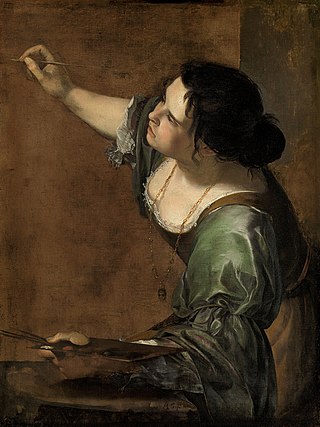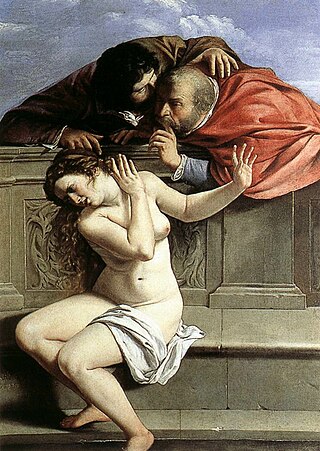
Guido Reni was an Italian painter of the Baroque period, although his works showed a classical manner, similar to Simon Vouet, Nicolas Poussin, and Philippe de Champaigne. He painted primarily religious works, but also mythological and allegorical subjects. Active in Rome, Naples, and his native Bologna, he became the dominant figure in the Bolognese School that emerged under the influence of the Carracci.

The Galleria Borghese is an art gallery in Rome, Italy, housed in the former Villa Borghese Pinciana. At the outset, the gallery building was integrated with its gardens, but nowadays the Villa Borghese gardens are considered a separate tourist attraction. The Galleria Borghese houses a substantial part of the Borghese Collection of paintings, sculpture and antiquities, begun by Cardinal Scipione Borghese, the nephew of Pope Paul V. The building was constructed by the architect Flaminio Ponzio, developing sketches by Scipione Borghese himself, who used it as a villa suburbana, a country villa at the edge of Rome.

Artemisia Lomi or Artemisia Gentileschi was an Italian Baroque painter. Gentileschi is considered among the most accomplished seventeenth-century artists, initially working in the style of Caravaggio. She was producing professional work by the age of 15. In an era when women had few opportunities to pursue artistic training or work as professional artists, Gentileschi was the first woman to become a member of the Accademia di Arte del Disegno in Florence and she had an international clientele.

Susanna, also called Susanna and the Elders, is a narrative included in the Book of Daniel by the Catholic Church, Oriental Orthodox Churches and Eastern Orthodox Churches. It is one of the additions to Daniel, placed in the Apocrypha by Protestants, with Anabaptists, Lutherans, Anglicans and Methodists regarding it as non-canonical but useful for purposes of edification. The text is not included in the Jewish Tanakh and is not mentioned in early Jewish literature, although it does appear to have been part of the original Septuagint from the 2nd century BC, and was revised by Theodotion, a Hellenistic Jewish redactor of the Septuagint text.

Orazio Lomi Gentileschi (1563–1639) was an Italian painter. Born in Tuscany, he began his career in Rome, painting in a Mannerist style, much of his work consisting of painting the figures within the decorative schemes of other artists.

Agostino Tassi was an Italian rapist, landscape and seascape painter, and was convicted of raping Artemisia Gentileschi in 1612.
Events from the year 1610 in art.

Massimo Stanzione was an Italian Baroque painter, mainly active in Naples, where he and his rival Jusepe de Ribera dominated the painting scene for several decades. He was primarily a painter of altarpieces, working in both oils and fresco. His main subject matter was biblical scenes. He also painted portraits and mythological subjects. He had many pupils and followers as his rich color and idealized naturalism had a large influence on other local artists, such as Francesco Solimena. In 1621 Pope Gregory XV gave him the title of Knight of the Golden Spur and Pope Urban VIII made him a knight of St. John around 1624 and a knight of the Order of Christ in 1627. From then on, he liked to sign his works as "EQUES MAXIMUS".

Judith Slaying Holofernes is a painting by the Italian early Baroque artist Artemisia Gentileschi, completed in 1612-13 and now at the Museo Capodimonte, Naples, Italy. The picture is considered one of her iconic works. The canvas shows Judith beheading Holofernes. The subject takes an episode from the apocryphal Book of Judith in the Old Testament, which recounts the assassination of the Assyrian general Holofernes by the Israelite heroine Judith. The painting shows the moment when Judith, helped by her maidservant Abra, beheads the general after he has fallen asleep in a drunken stupor. She painted a second version now in the Uffizi, Florence, somewhere between 1613 and 1621.

Susanna and the Elders is a 1610 painting by the Italian Baroque artist Artemisia Gentileschi and is her earliest-known signed and dated work. It currently hangs at Schloss Weißenstein in Pommersfelden, Germany. The work shows an uncomfortable Susanna with two men lurking above her while she is in the bath. This was a popular scene to paint during the Baroque period. The subject matter comes from the deuterocanonical Book of Susanna in the Additions to Daniel. Susanna and the Elders was one of Gentileschi's signature works. She painted several variations of the scene early in her career.

Esther Before Ahasuerus is a painting by the 17th-century Italian artist Artemisia Gentileschi. It shows the biblical heroine Esther going before Ahasuerus to beg him to spare her people. The painting is now in the Metropolitan Museum of Art in New York, having been donated to the museum by Elinor Dorrance Ingersoll in 1969. It is one of Gentileschi's lesser known works, but her use of lighting, characterization, and style help in successfully portraying Esther as a biblical heroine as well as the main protagonist of the work.

Self-Portrait as a Female Martyr, is also known as the Self-Portrait as a Martyr Saint. This painting was created by the Italian female artist, Artemisia Gentileschi. This self-portrait was made around 1615 depicting the artist herself as a martyr. It is one of two paintings by Gentileschi painted with oil on a wood panel. This self-portrait is currently in a private collection in the United States.

The Portrait of a Gonfaloniere is a painting by the Italian baroque artist Artemisia Gentileschi. It hangs in the Palazzo d'Accursio, Bologna. It is a portrait of an unknown gonfaloniere standing in full regalia and was painted in 1622. Mary D. Garrard has speculated that the man may be Pietro Gentile of Genoa.

Susanna and the Elders is a 1652 painting by the Italian artist Artemisia Gentileschi. It currently hangs in the Pinacoteca Nazionale, Bologna. The painting, over two metres broad, was completed in collaboration with Gentileschi's pupil Onofrio Palumbo - documents relating to the sale of the painting mention a payment to Palumbo.

Susanna and the Elders is one of several paintings on this theme executed by the Italian baroque artist Artemisia Gentileschi. This version, painted in 1649, hangs in the Moravská galerie, Brno, Czech Republic. It is signed with Gentileschi's signature, and the date, on the balustrade on the right.

Lucretia is a painting by the Italian baroque artist Artemisia Gentileschi. It depicts Lucretia, the wife of Roman consul and general Tarquinus, at the moment of her suicide. The decision to take her own life was made after she was blackmailed and raped by a fellow soldier of Tarquinus. It is one of a number of paintings of Gentileschi that focus on virtuous women ill-treated by men.

Judith Slaying Holofernes c. 1620, now at the Uffizi Gallery in Florence, is the renowned painting by Baroque artist Artemisia Gentileschi depicting the assassination of Holofernes from the apocryphal Book of Judith. When compared to her earlier interpretation from Naples c. 1612, there are subtle but marked improvements to the composition and detailed elements of the work. These differences display the skill of a cultivated Baroque painter, with the adept use of chiaroscuro and realism to express the violent tension between Judith, Abra, and the dying Holofernes.

Mary Magdalene in Ecstasy is a painting by the Italian baroque artist Artemisia Gentileschi. It is in a private European collection.

Bathsheba is a 1636-37 painting by the Baroque painter Artemisia Gentileschi, with contributions by Viviano Codazzi and Domenico Gargiulo. It shows the Hittite woman Bathsheba being washed and tended to by her servants. At the top left of the painting, King David sees her from his palace. It was one of seven versions from the story of Bathsheba that Gentileschi painted.

Susanna and the Elders is an Old Testament story of a woman falsely accused of adultery after two men who, after discovering one another in the act of spying on her while she bathes, conspire to blackmail her for sex. Depictions of the story date back to the 9th century, but were infrequent until the Renaissance.


















